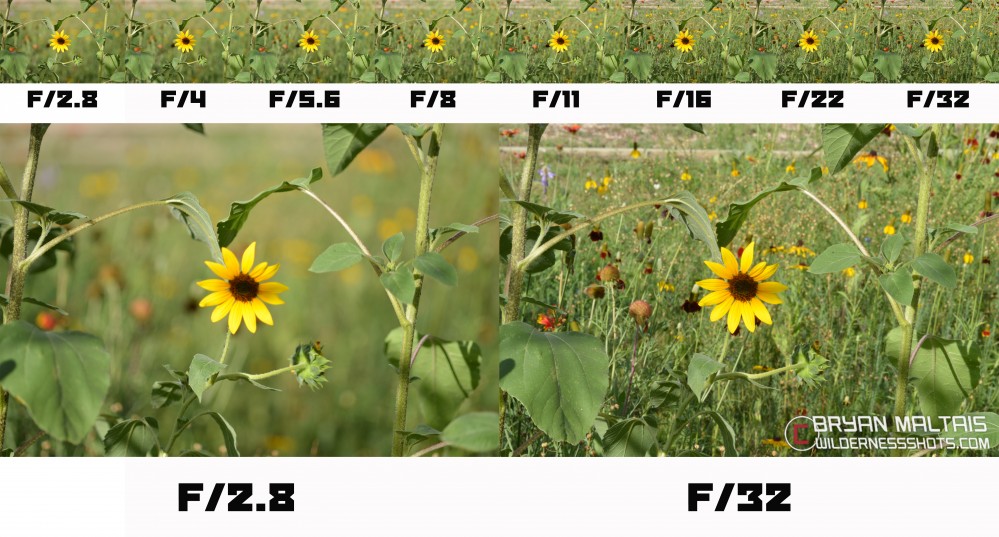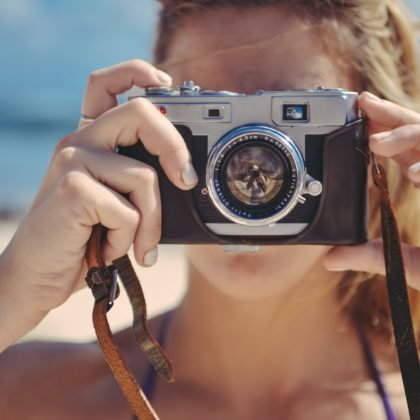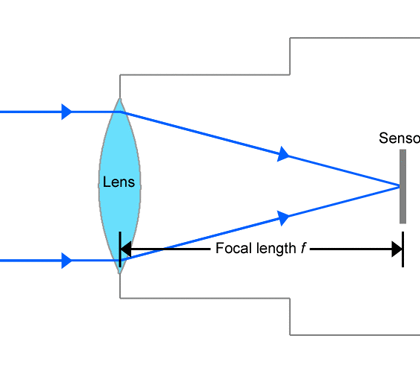
Welcome to Our Easy to Understand Aperture Definition Guide for Beginner Photography
What is the Definition of Aperture?
Like many concepts in beginner photography, understanding Aperture can be challenging so our goal is to really make it easy to understand in this Aperture Photography Guide. At it’s simplest definition, Aperture refers to the opening of a lens’s diaphragm through which light passes.
What is the lens diaphragm and how does it control how much light passes through the lens aperture?
The Diaphragm
 Whether in an eye or photography camera lense the role of the diaphragm is to stop the passage of light, except for the light passing through the aperture. Thus it is also called a stop (an aperture stop, if it limits the brightness of light reaching the focal plane, or a field stop or flare stop for other uses of diaphragms in lenses), calibrated by f/stops. The diaphragm is placed in the light path of a lens or objective, and the size of the aperture regulates the amount of light that passes through the lens.
Whether in an eye or photography camera lense the role of the diaphragm is to stop the passage of light, except for the light passing through the aperture. Thus it is also called a stop (an aperture stop, if it limits the brightness of light reaching the focal plane, or a field stop or flare stop for other uses of diaphragms in lenses), calibrated by f/stops. The diaphragm is placed in the light path of a lens or objective, and the size of the aperture regulates the amount of light that passes through the lens.
So as you can see the smaller the diaphragm size in a lens, the larger the remaining aperture, meaning greater exposure to light. Conversely, the larger the size of the diaphragm is opened in the lens, the smaller the remaining opening or aperture is, so there is less light exposure. Remember the diaphragm is literally used to STOP the light enters the lens, what’s left open is the APERTURE.
Aperture is Measured in F/Stop (which can be thought of as the size of lens diaphragm)
That’s why on a Camera Lens, the Aperture is referred to by the F/Stop number. The F/stop has a lot of different ranges but sometimes people get confused because the smaller f-stop number equals the larger aperture. But if you remember that the F/Stop number literally refers to the size of the Diaphragm in the lense that is meant to block the amount of light that is let through, then it will make a lot more sense and be easier to remember that the smaller F-stop number refers to a smaller diaphragm and larger aperture. Here is a visual representation of the various lenses and apertures.

Why Aperture so Important in Photography & Comparison to Human Eye
Aperture is perhaps the most influential parameter of photography, aperture plays an important role in the composition and setting up a shot. Let’s take a closer look. Simply put, the aperture is the hole in the lens through which light travels into the camera body and onto the camera sensor. To understand, let’s look at the human eye.
 All cameras are designed like human eyes. The cornea of our eye is similar to the front element of the lens, gathering light and bending it inward toward the iris. The iris can expand or shrink to control the size of the pupil, which passes light into the inner eye. The pupil is what we refer to as the aperture in photography. The amount of light that falls onto the retina is determined by the size of the pupil. The larger the pupil, the more light falls on to the retina. The larger the aperture of the lens, the more light enters the camera. The iris of the lens controls the size of the aperture and is called the diaphragm. The diaphragm’s function is to block all light, with the exception of light that goes through the aperture.
All cameras are designed like human eyes. The cornea of our eye is similar to the front element of the lens, gathering light and bending it inward toward the iris. The iris can expand or shrink to control the size of the pupil, which passes light into the inner eye. The pupil is what we refer to as the aperture in photography. The amount of light that falls onto the retina is determined by the size of the pupil. The larger the pupil, the more light falls on to the retina. The larger the aperture of the lens, the more light enters the camera. The iris of the lens controls the size of the aperture and is called the diaphragm. The diaphragm’s function is to block all light, with the exception of light that goes through the aperture.
A closer look at F/Stops in Photography Aperture
As we mentioned before in photography the aperture is expressed in F numbers, also known as F stops. F stops are a way of describing how open or closed the aperture is. The smaller the F-stop means a larger aperture, while a larger F stop means a smaller aperture. For most this can be tricky to remember, but not you since you are reading this j/k, since large F stops mean small aperture sizes. An Aperture F-stop of F/1.4 is larger than F/2.8 and much larger than F 8 or F 11.
Aperture Impact of Depth of Field
Aside from controlling the amount of light passing through the lens and into the camera, the aperture has a direct impact on the depth of field, the area of the image that appears sharp. A large F number such as F 16 will bring all foreground and background objects into focus, while a small F-number such as F 1.4 will isolate either the foreground or background objects and make everything else blurry.
Here is an example of Aperture impact on Depth of Field, comparing F-stop number of F/2.8 and F/32

Guidance on Aperture and Photography Lenses
Every lens has a limit on how large or small the aperture can get. If you take a look at the specifications of your lens, it should indicate the maximum apertures, lowest F numbers, and minimum apertures, highest F numbers. The maximum aperture of the lens is much more important than the minimum aperture because it shows the speed of the lens. Lenses with apertures of F 1.4 or F 2.8 are considered fast lenses because they can pass more light into the camera than for example a lens with a maximum aperture of F 4 or F 5.6. That’s the reason night photography usually requires fast lenses.
The minimum aperture of a lens is usually not important and should rarely be used, as de-fraction will cause the image to lose clarity.
It is also worth noting the two types of lenses, primes and zooms. Primes have a fixed focal length, meaning they cannot zoom without physically moving closer or further away from the subject. Zoom lenses give you the flexibility for you to zoom in or out of an object while remaining stationary. While prime lenses will have a fixed maximum aperture, the maximum aperture of a zoom lens will often get smaller as the focal length increases. These lenses are called variable-aperture lenses. This is important, because, for a zoom lens with a focal length of 70 to 200 millimeters, the aperture may increase from F 3.5 to F 5.6, decreasing the amount of light entering the camera.
For more information read our complete beginners guide to different types of Camera Lenses.
How does Aperture affect ISO and Shutter Speed?
Because aperture controls the amount of light entering the camera, it also affects other parameters, such as ISO and shutter speed. A larger aperture, or smaller the F-number, will let more light into the camera, allowing you to use a faster shutter speed or lower ISO value. This is beneficial to eliminate motion blur and reduce the amount of noise that your camera will produce if it’s ISO gets bumped up.
Faster shutter speeds can be essential in scenes with lots of motion, like sports and wildlife photography. A fast lens can help increase your shutter speed, or decrease your ISO value if your shutter speed is set to a specific value. Fast lenses are also imperative for any kind of nighttime photography. Whether you’re taking pictures of the Milky Way or dong a moonlit photo shoot, large apertures will let as much light in as possible. Small apertures can be useful as well. Shooting landscape scenes require everything in crisp focus, so smaller apertures will sharpen any out-of-focus areas that may come about.
To enable manual adjustment of aperture values, set your camera to either aperture priority or manual mode. Aperture priority will let you change aperture values manually while leaving shutter speed and ISO up to the camera’s internal metering system. Manual mode lets you control every aspect of the camera, allowing you to change ISO, aperture, and shutter speed. I personally leave my camera in aperture priority mode 99% of the time for most types of photography. With all this information, you should be able to start using your lenses and cameras to the best of their ability. Aperture is probably the most stylistic setting you can change on your camera, allowing for unique effects that can take your images to the next level.
Conclusion to our Aperture Definition Photography Training
We hope you enjoyed this training on Aperture and now feel like you better understand its definition, how to manipulate it with your camera lens, and the effect it will have your photography. We hope you enjoyed this article and want to thank you for reading! A Reminder some of the links in this article and across our site are affiliate links and if you purchase something through one of those links we will get a small commission, it’s how we keep the lights on and continue to provide helpful training for free, also they never increase the price you pay for an item. If you decide to use one of these links we want to THANK YOU! its much appreciated, but if you are uncomfortable with that, no worries at all we are still glad you stopped by and hope you will again! Remember learning never ends and while we try to make all our training thorough and easy to understand, never stop learning!






